Filmmaker Stephen Mitchell recently wrote “Rendezvous Redux” for VeloceToday. Below, for the first time, is the full story behind Stephen Mitchell, the amazing YouTube videos and GTO 3987. And whether you view the two film clips before or after reading the article make sure you do and watch them all the way through. You will be amazed. Trust me.
In early 1964, Car and Driver’s Editor David E. Davis thought it would be a great idea to compare the new Pontiac GTO with a real Ferrari GTO, and bet the March cover on it. Came the big day and a Ferrari GTO couldn’t be found. Uh-oh.
Exactly one year later, they tried it again, but the best they could do was find a four headlight 330GT to run up against a Pontiac 2+2. A cop out. And still, no real GTO.
But in mid 1960s—perhaps the peak years of best years of our lives as impressionable adolescent car nuts, a teenager by the name of Stephen Mitchell, living in Woodland Hills, California, was driving his very own Ferrari GTO serial number 3987 back and forth to Valley College, to the drive in movies, on dates, and perhaps best of all, cruising Van Nuys Boulevard and Mulholland drive, accompanied by his friends in only slightly more mundane means of transportation, such as Peter Helm with a 250GT California. Nor was it a fleeting moment; Mitchell kept the GTO for four years before giving up the reins.
And this was perhaps the epitome of car cool. For there was Mitchell, of golden age living in the golden state during the golden years before everything fell apart and down, and driving, for chrissake, a Ferrari GTO…was there anything that could possibly be more of the stuff of songs and legends and movies that constantly filled our empty little heads? It seemed that Stephen Mitchell, riding the crest of the car culture craze with the bossest car ever built, was truly living the dream we all dreamt.
But was it all that we imagined?
California Car Culture
We all gather together in California once a year for Holy Week because California was, is now and probably will be forever the center of the automobile car culture in the Western Hemisphere. During the 1950s and 60s, thousands of other towns and cities in the U.S. echoed the good vibrations of the post war love of cars but California was in a class by itself, caught in the vortex of a postwar boom, a burgeoning teenage culture, and a phenomenon known as the Four H club—hotels, highways, hamburgers and houses, which needed the automobile and the Interstate system to connect them. In a post war building boom, always sunny California would be planned, mapped and configured and built around the automobile.
Indianapolis, right in the heart of America, remained the focus of open wheel racing in the U.S., but many of its most famous drivers, builders and engines hailed from California. Hot Rods were literally an invention of pre-war speed seekers who took their modified Model Ts (some with Peugeot style four valve heads) to the dry lakes in California’s deserts. Sports car racing, often distinctly separate from hot rodding, got its start before the war on the East Coast but imported to California after WWII it went viral. And as Dean Batchelor pointed out, many of the early hot rodders, himself, Phil Hill, Dan Gurney and Richie Ginther included, went on to great things with sports cars. In the early 1960s, an eastern newspaper reporter Tom Wolfe attended a Ford Custom Caravan “Teen Fair” in Burbank, discovered the strange custom hot rod world of Ed Roth and George Barris, wrote “The Kandy Kolored Tangerine-Flake Streamline Baby” ; all three went on to even greater fame. At about the same time, Car and Driver, still stodgily ensconced in NYC, tossed up a special feature on the State of affairs which could no longer be ignored by Detroit or New York. “California is a car enthusiast’s paradise. It has everything…It has the wealth and a booming economy that makes most dreams come true…You can build, buy, race, change or restore anything on wheels almost any day of the week.”
Singing Ferrari Wannabees
Into this highly combustible California milieu enter the Mustang, the Cobra, and the Pontiac GTO, all in one way or a lesser reflection of a rare car generally known only to a few as the Ferrari Gran Turismo Omologato. Introduced in April of 1964 with a base price of $2368, Iacocca’s rebodied prancing horse Falcon was described by an Iacocca underling as “putting falsies on grandma” but the pony car sold over a half million units in its first full year of production even before Wilson Pickett’s “Mustang Sally” in 1966.
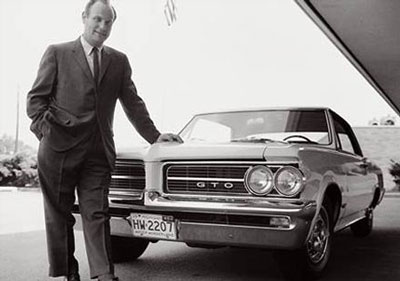
Jim Wangers was a Pontiac marketing manager who teamed up with John DeLorean to capture the growing youth market. Although Ford was touting ‘Total Performance’ since 1962, it was DeLorean who realized the potential of a big block in a little car and created the GTO. Detroit’s Woodward Boulevard nearly outranked California’s Van Nuys as cruising Nirvana and was used for impromptu testing by Detroit’s young engineers.
The Pontiac GTO was introduced in the fall of 1963, but to much less fanfare and far fewer sales than the Mustang, reaching only 32,000 in 1964. Sales would soon increase dramatically, helped by a remarkable marketing effort by Pontiac’s Jim Wangers, who pushed the song “GTO” by Ronnie and the Daytonas, while John DeLorean, who stole the name from Ferrari, continued to refine and add horsepower to what was once a Pontiac Tempest. The sales of both cars were driven by a huge number of young people who were just getting their driver’s license. As Iacocca said, “this is the buyingest age group in history.” And if “Abigail Beecher”, (Freddy Cannon, 1964) the history teacher drove an XKE, the least the kids could do was to ask their parents for a new Mustang.
Following suit, Carroll Shelby’s Cobra began with a Ford 260, moved quickly to the 289 and then stuffed the Ford 427 block into what was left of the AC chassis. No one save perhaps Shelby himself noted the irony that the AC body was styled directly from the Ferrari 166 MM. The Cobra too, had its mascot song, “Hey Little Cobra” by a group called the Rip Chords. Ford was impressed with Shelby but also wanted to go their own way. “Give the guy money and send him away” said Iacocca after Shelby begged for money for the first Cobra. In June of 1962 Henry Ford II withdrew from the Detroit Safety Resolution which discouraged racing and the horsepower ratings battle. A golden age had begun.
By 1967 the muscle car, baby boomers, sports car racing, the Ford racing effort at Le Mans and the Cobra in the international GT class were all coming to a peak.
And that’s when Stephen Mitchell found 3987, resting quietly after a string of victories in the hands of Pedro Rodriquez, Roger Penkse, Augie Pabst and Richie Ginther.
The Ultimate Niche group
If as Tom Wolfe had found, that hot rods and racing were a niche culture even in California, the sports car community was a niche within a niche. Stephen Mitchell would discover that world while lying in a hospital bed recovering from a head-on car collision at the age of 14.
“The real significance of my accident is that it took me out of a peer group environment where I was completely uninfluenced by what was ‘cool at school.’ I found my own cool in the writings of Henry N. Manney lll and others who wrote about the European car scene.” said Mitchell. He joined the niche group of guys who read Road & Track rather than Hot Rod and Sports Illustrated.
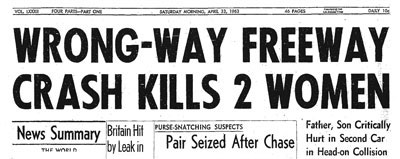
April 13, 1963; the L.A.Times splashed the news of Stephen Mitchell’s head on collision caused by two young women driving on the wrong side of Ventura Freeway. Mitchell, then 14, and his father were both critically injured but both eventually recovered. While in the hospital, Mitchell began to read Road & Track and found a new kind of cool
After recovery, Frank Sinatra arranged for Mitchell to obtain a Screen Actor’s Guild card, which meant he could get work in Hollywood productions. He discovered he made enough money working as an extra and acting in small parts after to buy and sell European cars. He’d make trips to London and bring back Bentleys, and was then able to afford to own an E-Type Jag and Ferraris for personal use. Being in the right time at the right place, and by now, exempt from the draft due to the accident, was a mixed blessing. “Life dealt me some very good and some very bad cards.but I’ve worked very hard for what I’ve been lucky enough to enjoy.”
Mitchell was both lucky and astute enough to realize that in 1967, when William Reinhardt, who was said to be a music arranger for Sonny and Cher, wanted to sell a Ferrari GTO with a blown engine, he would have the ultimate street Ferrari. (Reinhardt had bought the car from Mark Slotkin who had acquired the car from Otto Zipper but neither are listed as an owner of 3987 in either the Bluemel/Pourett book or Pritchard’s.) “I paid $7000 plus the cost of an engine rebuild,” said Mitchell. (At the time, a new Shelby Mustang listed at around $4200, a new Ferrari 330 GT at $14,200). “The 250GTO #3987 was the third car I’d ever owned for personal use. The first was a 3.8 E-Type Jaguar. The second was a Ferrari Berlinetta Lusso that loved the canyons of L.A. as much as it did the highway.”
Cruising for Crumpet
Michael T. Lynch noted in last week’s VT that the E Type Jag was hailed as the ‘greatest crumpet catcher known to man”, but many girls were not always attracted to the same cars guys imagined they might be.
Many girls thought sports cars were noisy and uncomfortable. Even hot rodders had problems; cruising didn’t’ always mean scoring. Girls seldom hopped into the first deuce coupe that drove by. “The reality of the situation was that finding a new flame while cruising wasn’t that easy,” wrote hot rod historian Michael Karl Witzel. It wasn’t easy even with a GTO.
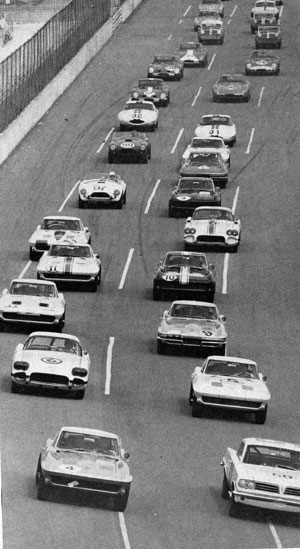
On February 1963 the Mitchell GTO (at the rear with racing stripe) was busy mixing it up with the Vettes, Cobras, and Pontiac Tempests at the three hour Daytona Continental. Penske drove to second place while Rodriquez finished in first with another GTO. The introduction of the Pontiac GTO was a few months away yet.
Girls could see hot rods in movies, Mustangs and Pontiacs on the streets, Cobras in ads, but few had any idea of what a Ferrari GTO was and surely didn’t read Manney the third at lunch. In those halcyon days, Patricia Lee Yongue (now an Associate Professor at the University of Houston) cruised the streets of San Francisco with her new white Pontiac GTO. Well informed about cars, she knew that Ford had won at Le Mans, but Ferrari’s GTO? “I had never heard of a Ferrari GTO, and was never told what GTO meant or what language it was. We simply called my Pontiac ‘The Goat.’” The airwaves may have been filled with music about Cobras, Stingrays, and even Honda bikes but no one would ever listen or dance to a popular song about something called a Ferrari. Though Mitchell often cruised the famous Hollywood venues with the Ferrari; “Truth be told, I attracted as many women in a beat up VW Bug as I did in the GTO though the only time I was flashed by a woman in a crosswalk was when I was at the wheel of the GTO,” he recalled.
Like many of us, whether the car was a Ferrari GTO or a Lancia Zagato, Mitchell didn’t buy a particular car because others knew what it was or for the approbation of the crowd, or to attract girls—“we bought them for the aesthetics of the design and the performance.”
Girls or not, Mitchell was front and center in the California car world famed in movies, books, and records. “I loved the hot rod scene. A fellow I knew in auto shop at high school installed a Corvette engine in the back seat of a Renault Dauphine. A neighbor had a ’57 Chevy that looked like it belonged on a drag strip. I cruised Van Nuys (and the Sunset Strip) in the Lusso, the GTO, a James Young Bentley and, later, (reliving Jan and Dean’s “Dead Man’s Curve”) in a very nice ’67 Corvette Stingray coupe.” Cruising was getting out of hand. In 1967 about 100 cruising teens took over a McDonald’s restaurant on Whittier Boulevard, drove in and refused to leave; such actions brought about local ordinances which effectively muted the cruising scene at the drive ins.
Ins and Outs
Owning a Ferrari at such a young age had its price, often putting him outside of the social norm. When he drove his Lusso to high school or the GTO to Valley College, he would hear people whispering in the hallways, “That’s the guy with the Ferrari!” And when the bell rang after the final period, “I was gone like a shot! School was like a daily detention for me from which I was quick to escape. I really had only one school friend and he drove a three liter Austin-Healey that he liked to get sideways. We would go to movies on Friday nights and end up in his uncle’s Italian restaurant for a late dinner.”
He found others in that cult within a cult though. Mitchell fell in with actor Peter Helm who had also discovered Ferraris as a way of life. He spent countless evenings in Matthew Ettinger’s night club. Ettinger, though 15 years older than Mitchell, owned another very special Ferrari, the Breadvan. See Ettinger Interview
At night, the Mitchell GTO and the Breadvan parked in the VIP spots at the door–they would take the girls they met that night to breakfast when the club closed at two in the morning. “One night, I was sitting in the GTO at a Bob’s Big Boy drive-in having a hamburger and chocolate shake when I heard the unmistakable sound of a Ferrari V12. It pulled into a space nearby and I recognized the driver and the car. It was Jimmy DiNatale–Sal’s son–in a SWB Berlinetta. He waved, I nodded. We’re cool.”
It was Helm who did the filming seen in the YouTube clips at both Willow Springs and on the canyon roads of Los Angeles and is also the one whose antics behind the wheel of his 250GT California put the legendary Ferris Bueller to shame. The Willow Springs episode was the result of another GTO owner who wished to have a farewell party for his GTO and invited Chris Cord with his GTO, Mitchell with his and the three were filmed at speed. The film clips remained with Helm until 2008, when Mitchell had attended the 45th anniversary of the GTO at Infineon Raceway. (see video) “This put me back in touch with many people I’d known in the Ferrari world. I was able to get Peter’s phone number from fellow FOC member Ed Niles and we got together to go over old times.” In the course of this conversation, Helm reminded Mitchell about the ancient footage, most of it from 1969. “Peter gave me footage of The Great Putdown which I edited slightly and to which I added my own narration. Later, I took the raw footage of our day at Willow Springs and other footage shot by Peter of the GTO in the canyons of Los Angeles and edited that into a visual document of sorts–again adding my narrative.”
In late 1970 or ’71, in order to finance a car buying trip to Italy, Mitchell sold the GTO to Alain de Cadenet, who needs no introduction. Eventually 3987 was bought by Ralph Lauren in 1985 for over a half million dollars, starting the GTO feeding frenzy. It resides with Lauren to this day.
Mitchell’s parting shot: “To this day, GTO 3987 remains an active ingredient in my life opening doors to the most extraordinary people and situations one could imagine. Owning the car at the time was like living in a Hollywood movie. Remembering it today is like entering into a fantasy world of perfection. When I was asked to summarize the car, my response was simple: Every moment in the GTO was like the first lap at the 24 Hours of Le Mans.”
And so, was it all that we imaged it was? Dreams always exceed reality, few people knew what a Ferrari GTO was, girls didn’t care, and maybe the jocks had more fun after all. And along with the sale of Stephen’s GTO in 1970 went the truly good years, But in many ways, while it lasted, for Stephen it indeed must have been living in a Hollywood movie.
Envy’s not so bad, is it?
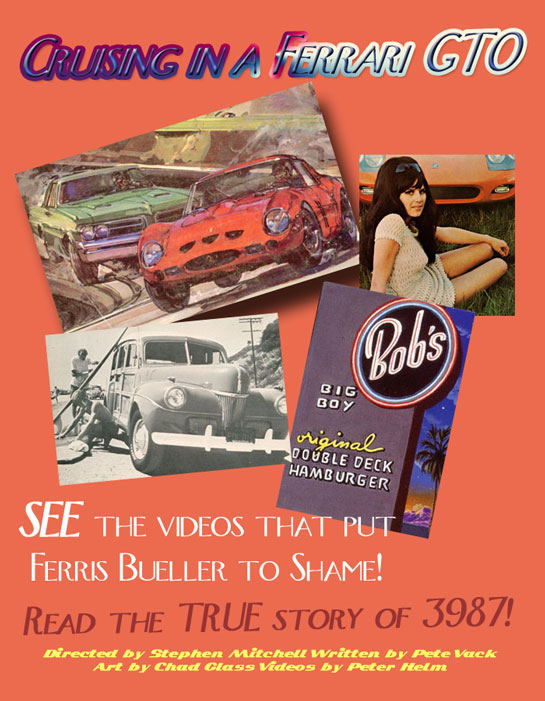
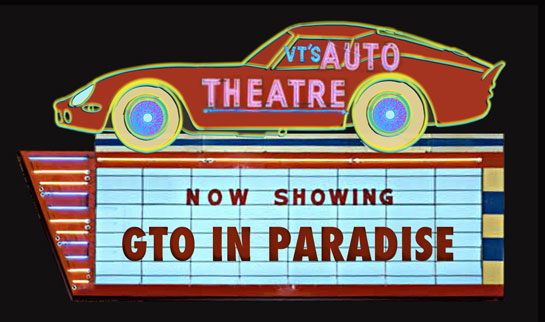
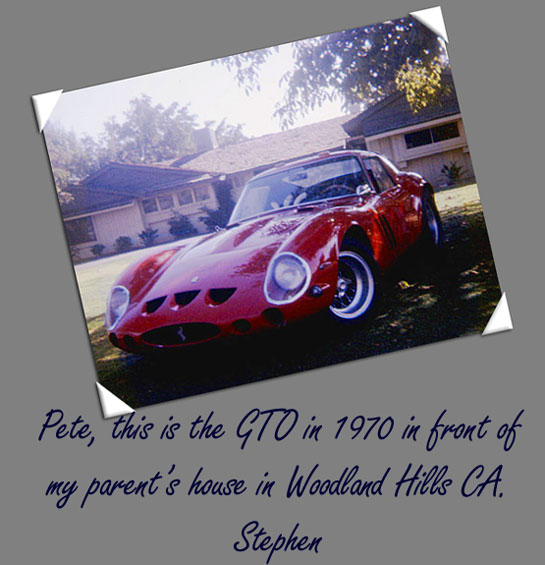
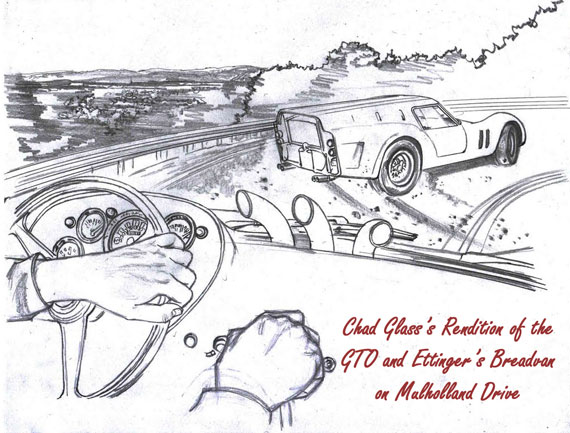
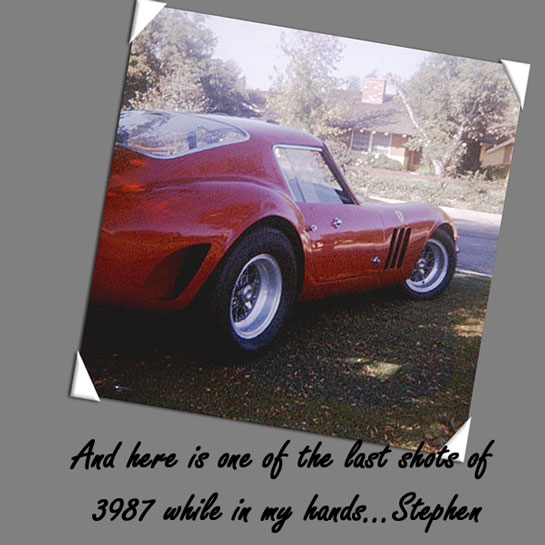
Great article on the early car culture. I used to clear my head after a days work in my ex LeMans Abarth-Simca 1300 with the stinger exhaust-Great sound! ,but not to compare ro my beater 250 GTE with the exhaust cut off after the first muffler- wish I had those two back!
Mark, I wish you had them back, too! There’s nothing like performance cars of that era for personality and their ability to distract from the chores of life.
Extremely interesting article. The thrill of a lifetime, and a dream very few will ever enjoy. Fond memories and future “rides”. Great footage in “GTO’s at Willow Springs”, and “The Great Putdown”. Thanks for sharing.
Thank you, Kip!
I commented on one of the other articles on these GTO’s
but the article and video is worth more than one comment.
as a far younger man I drove my Singer daily on Mullholland Drive. I only can wish it was in a GTO. Same goes for Willow Springs
You done good!
Thank you, Jack! Mulholland is a great challenge regardless of the car. The GTO put it over the top.
Hey Mark- Understand the So Cal car thing as I was one of those Porsche Speedster guys while going to High School in 1966. Racing up to Idyllwild ditching 5th and 6th period classes for timed runs. That’s what a few of us did in Hemet, Ca. it was like having a race track in you back yard ! Actually Riverside Raceway was only 19 min. with race tires, open exhaust and no windshield. It’s a good thing my Girlfried accepted that I loved my car more than Her as she would camp overnight on race weekends in the pits sleeping in a tent. Breaking in new race motors leaving Hemet with the top down at 3AM driving up to Anza and back by sun up……Living the dream at sixteen ! Thanks for shareing ! SS
Terrific article and film clips. But I have to disagree about one thing. Had you driven past ME in your 3987 when I was eigtheen, this girl CERTAINLY would have jumped in your car! Not all girls were ignorant of a Ferrari in those days.
Wat a special time that was. The carefee pleasure you had then seems to be sorely missing from the Ferrari world these days. I join others in thanking you for sharing your memories!
Mary Ann,
Would that we had crossed paths! I think Pete downplayed the obvious for the sake of propriety. I remember someone telling me at the time, “I don’t know what it is but I know it’s really something!”
It was, indeed, a special time with a kind of counter-culture enthusiasm that is at a low ebb today. It can still be found at my Elysée Wednesday gatherings and if you are ever in Los Angeles on a Wednesday evening, we’d love to have you join us!
Stephen
When I was a teenager I use to detail cars for the owners of a clothing company called Chemin De Fur Jeans. (David Gaon and Spencer Stillman) one day they decided to change the steering wheel on their 1963 Ferrari GTO serial number 3987. Instead of paying me for the detail on their Ferrari, they gave me the steering wheel instead. I still have that steering wheel! And just recently learned that a GTO sold in February 2012 for over $30,000,000. I also use to detail James Coburns short wheel base California spider, which he bought in Brussels for $7,000 and later sold it to Andy Cohen for a few more dollars than that. Who could foresee the value of the older ferrari.